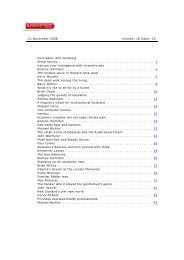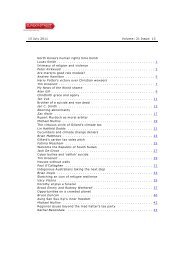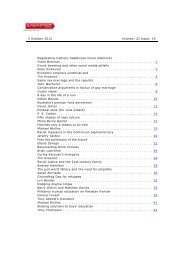17 June 2011 Volume: 21 Issue: 11 Australia's ... - Eureka Street
17 June 2011 Volume: 21 Issue: 11 Australia's ... - Eureka Street
17 June 2011 Volume: 21 Issue: 11 Australia's ... - Eureka Street
Create successful ePaper yourself
Turn your PDF publications into a flip-book with our unique Google optimized e-Paper software.
<strong>Volume</strong> <strong>21</strong> <strong>Issue</strong>: <strong>11</strong><strong>17</strong> <strong>June</strong> <strong>20<strong>11</strong></strong>is crowding out growth and investment in other areas.The potential damage of this scenario is obvious to anyone who lives in Ravensthorpe, WA,which was left devastated when BHP Billiton closed down its nickel mine there. The formeragricultural town closed down virtually overnight after the mining giant decided to pull theplug. All that is left now are half finished homes, built in anticipation of the mine’s long termoperation.If things continue at the current rate, the whole of WA and North Queensland will be left asabandoned wastelands when the boom ends, as itinerant workers flee and leave behindhalf-empty towns and cities without an economic base.Hockey’s opinion that the economy ‘is increasingly, obviously, reliant on the mining boom’is not only incorrect (the financial and manufacturing sectors actually account for more GDPgrowth than the resource sector), it’s dangerous. Placing mining at the ‘centre of economicpolicy’ as Gillard would have it condemns Australia to be a bimbo economy. We must aspireto more than that.If Australia is to continue to grow it needs to be equipped to do more than dig things up forthe rest of the world. That means diversifying, investing in new technology and increasingproductivity.These are things that the resources sector has not done well in recent years. Between 2002and <strong>20<strong>11</strong></strong> productivity in mining halved, and as former Newcrest Mining executive Ian Smithadvised the Australian Minerals and Metals Association recently, it was all due to a relentlessgreed for profits.‘The IR landscape didn’t do that — we did that as an industry,’ he told an AMMAconference. ‘Because of the pricing of the commodities there has been an attitude where wewould do anything to get the project on while these prices prevail. We destroyed what wewere doing as the most productive industry within Australia.’This is not the kind of model that can sustain for very long. Short-term profiteering at theexpense of real productivity is not a secure basis for an economy; just ask anyone whoinvested money in an Icelandic bank.The resources sector brings real benefits to the Australian economy and needs to besupported, but the wider economy needs to be supported too, and that means bringingmining’s disruptive expansion under control.Part of the reasoning behind Ken Henry’s proposed mining tax was that it would help tobring mining sector growth back to a more sustainable level. A modest slow down wouldmaintain a healthy industry while giving the rest of the economy a break, helping to restoreAustralia’s growth to a more stable footing.©<strong>20<strong>11</strong></strong> <strong>Eureka</strong><strong>Street</strong>.com.au 2
















